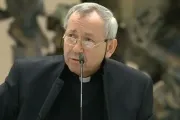Rome, Italy, May 1, 2010 / 09:00 am
Fr. Antonio Martello, a hospital chaplain was shocked to see that the baby boy he was praying over was still breathing, a day after he had been aborted at 22 weeks. The case of a "therapeutic" abortion in Rossano Calabro, Italy raises questions about the reliability of sonographies in diagnosing deformities.
Due to a perceived, and as yet unspecified, malformation of the fetus, possibly a cleft palate, the mother had solicited the abortion at a public hospital in the southern Italian city.
The "interruption" of the pregnancy was carried out in the early afternoon of April 24, Fr. Martello told Italy's Il Foglio newspaper this week. The day after, at 11 a.m., he went to pray for the child as he said he always does with aborted and stillborn children.
Noting movement under the sheet with which the babe was covered, the chaplain removed it and saw the child kick. "When I called for help and the pediatrician and anesthetist arrived ... they also observed that the baby was breathing, moving and that (his) heart was beating," he told Il Foglio.
"What I witnessed last Sunday had never happened to me before," said the priest, who was unable to make further comment due his involvement as a witness in the investigation of the case.


